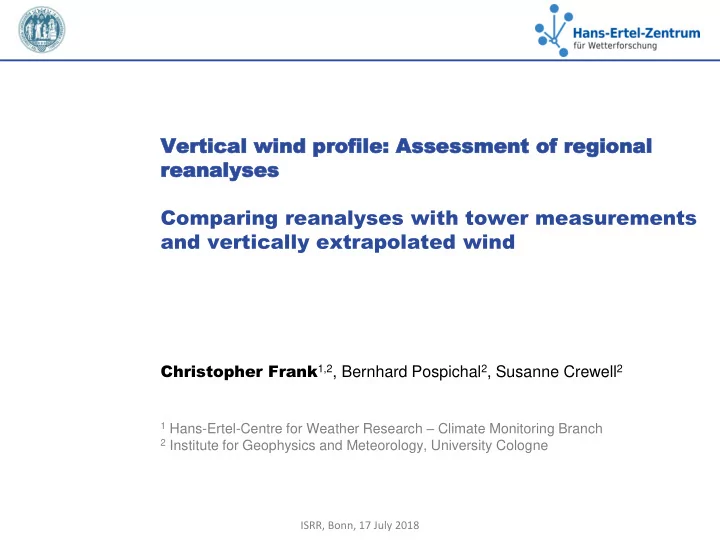

Vert Vertical ical wi wind nd pro profil file: e: Assessme Assessment nt of reg of regiona ional l re rean analyses alyses Comparing reanalyses with tower measurements and vertically extrapolated wind Christopher Frank 1,2 , Bernhard Pospichal 2 , Susanne Crewell 2 1 Hans-Ertel-Centre for Weather Research – Climate Monitoring Branch 2 Institute for Geophysics and Meteorology, University Cologne ISRR, Bonn, 17 July 2018
Motivation • Wind is often highly variable in space and time Gridded wind speed information are important for: e.g. public safety, traffic, renewable energy... • Site assessment for wind turbines needs best possible wind speed information (on various temporal and spatial scales) • State of the art assessments are often based on 1 year measurements taken significantly below hub-height. Hub-height wind speed is then estimated by vertical extrapolation. Error-prone, time consuming, and expensive • Consistent and reliable gridded wind source could revolutionize site assessment Central question: How do reanalyses perform compared to vertically extrapolated wind measurements and what are advantages of new regional reanalyses? ISRR 2018
Glob. reanalyses Regional reanalyses Era-Interim COSMO-REA6 COSMO-REA2 Europe ~80 km Germany ERA-INTERIM foreced COSMO-REA6 forced 60 levels 1995 - 2015 2007 - 2013 Often used in 40 levels 50 levels climate studies 6 km 2 km REA2 specifications: Convection-permitting, Latent-heat nudging MERRA-2 ~50 km 72 hybrid-eta levels Often used in renewable energy REA2 studies Bollmeyer et al. (2014) ISRR 2018
Tower measurements (Reference) Falkenberg Billwerder • 4 towers Cabauw • 10 min averages • 2007-2013 Karlsruhe REA2 Bollmeyer et al. (2014) Available height levels of wind speed from tower and reanalyses. Cabauw Karlsruhe Billwerder Falkenberg ISRR 2018
Extrapolation methods for surface 10m wind Power-law based extrapolation: Three methods from simple to complex: 1. 𝑄𝑀 - 𝑑𝑝𝑜𝑡𝑢: Constant exponent 𝛽 = 0.2 2. 𝑄𝑀 - 𝐼𝑇: Stability and roughness dependent exponent: 𝑑 0 , 𝑑 1 , 𝑑 2 are dependent on Pasquill-Gifford-SRDT stability classes 3. 𝑄𝑀 - 2𝑀: 2 level based exponents: The extrapolations are based on 10 and 40m measurements, except for Karlsruhe where a local forest forces the reference heights to 40 and 60m. ISRR 2018
Marginal distribution Billwerder 2007-2013 Falkenberg 2007-2013 Wind speed Wind speed • PL_const and PL_HS show underestimation • Distribution of PL_2L similar to that of the reanalyses ISRR 2018
Bias Cabauw Karlsruhe Billwerder Falkenberg • Roughness problems in Karlsruhe (regional rea‘s show advantage) • PL_2L provides best results at low roughness sites ISRR 2018
Mean absolute error (BC_MAE) Cabauw Karlsruhe • Reanalyses perform better Billwerder Falkenberg than extrapolations in ~100 m • PL_2L shows best quality – but needs the seconds measuring height. ISRR 2018
Stability condition Cabauw Extrapolation methods are stability dependent Based on the measured temperature gradient we define stabile, unstable, and neutral classes ISRR 2018
MAE under stable conditions Cabauw Karlsruhe • Accuracy of Falkenberg Billwerder extrapolated wind decreases fast even faster than for all conditions. • Especially in low heights regional reanalyses perform better. ISRR 2018
MAE under unstable conditions Cabauw Karlsruhe • Extrapolations, and also Falkenberg Billwerder reanalyses perform better under unstable conditions. • No systematically working best extrapolation method. ISRR 2018
Power estimate uncertainty Cabauw Karlsruhe Regional reanalyses show Falkenberg Billwerder smaller site dependence than the global ones, and the extrapolation methods. Errors are smaller in lower heights and less than about 25% above 50m. ISRR 2018
Conclusion • COSMO-REA6 and COSMO-REA2 outperformed the global reanalyses (Especially close to ground). • Under stable and neutral conditions • If only 10m wind extrapolations exist, reanalyses perform better in heights above 60m • If two measurement heights exist, reanalyses perform better in about 3 times above the higher reference height • In well-mixed conditions no systematic was found. Embedding this study This work is embedded in a broader study to exploit regional reanalyses for renewable energy purposes • Solar radiation (Frank et al., Solar Energy 2018) • wind (current work, will also be submitted soon) • Compund and counter-acting event analyses ISRR 2018
Recommend
More recommend